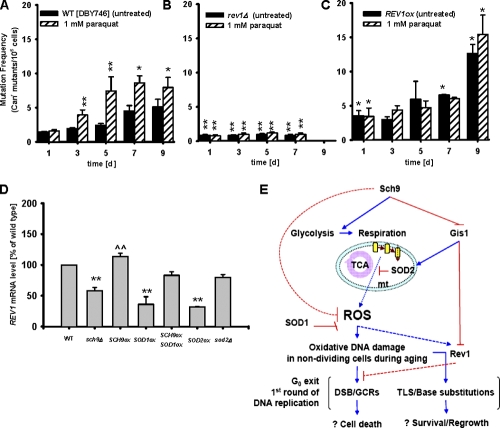Figure 9.
Rev1 mediates oxidative stress induced genomic instability. (A–C) Mutation frequency (Canr) of the wild type (DBY476), rev1Δ, and cells overexpressing REV1 (REV1ox) during chronological aging and under oxidative stress (1 mM paraquat at day 1 and at day 3). *, P < 0.05; **, P < 0.01; rev1Δ versus wild-type (WT) untreated, two-tailed t test at the indicated time points (n = 4). Error bars indicate ±SEM. (D) REV1 mRNA levels at day 3. REV1 mRNA level were normalized to ACT1 and represent mean ± SEM (error bars) of the percentage of wild type. **, P < 0.01; compared with WT. ^^, P < 0.01; compared with sch9Δ (two-tailed t test, n = 8–12). (E) Modulation of oxidative stress and genomic instability by Sch9. During chronological aging, the oncogene homologue SCH9 inhibits the expression of genes involved in glycolysis and promotes respiration. Sch9 also regulates the error-prone Polζ complex component Rev1 through the stress response transcription factor Gis1. Accumulation of oxidative DNA damage during aging activates Rev1-mediated TLS, which leads to increased base substitutions and reduced GCRs in the first round of DNA replication when cells exit the arrested state.

